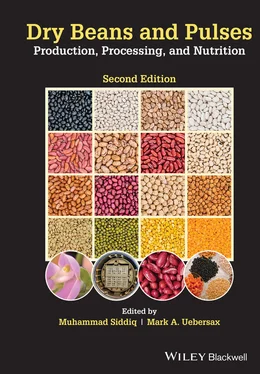Dry Beans and Pulses Production, Processing, and Nutrition
Здесь есть возможность читать онлайн «Dry Beans and Pulses Production, Processing, and Nutrition» — ознакомительный отрывок электронной книги совершенно бесплатно, а после прочтения отрывка купить полную версию. В некоторых случаях можно слушать аудио, скачать через торрент в формате fb2 и присутствует краткое содержание. Жанр: unrecognised, на английском языке. Описание произведения, (предисловие) а так же отзывы посетителей доступны на портале библиотеки ЛибКат.
- Название:Dry Beans and Pulses Production, Processing, and Nutrition
- Автор:
- Жанр:
- Год:неизвестен
- ISBN:нет данных
- Рейтинг книги:5 / 5. Голосов: 1
-
Избранное:Добавить в избранное
- Отзывы:
-
Ваша оценка:
- 100
- 1
- 2
- 3
- 4
- 5
Dry Beans and Pulses Production, Processing, and Nutrition: краткое содержание, описание и аннотация
Предлагаем к чтению аннотацию, описание, краткое содержание или предисловие (зависит от того, что написал сам автор книги «Dry Beans and Pulses Production, Processing, and Nutrition»). Если вы не нашли необходимую информацию о книге — напишите в комментариях, мы постараемся отыскать её.
The second edition of the most complete and authoritative reference on dry beans production, processing, and nutrition available Dry Beans and Pulses: Production, Processing, and Nutrition
Dry Beans and Pulses: Production, Processing, and Nutrition, Second Edition
Dry Beans and Pulses Production, Processing, and Nutrition — читать онлайн ознакомительный отрывок
Ниже представлен текст книги, разбитый по страницам. Система сохранения места последней прочитанной страницы, позволяет с удобством читать онлайн бесплатно книгу «Dry Beans and Pulses Production, Processing, and Nutrition», без необходимости каждый раз заново искать на чём Вы остановились. Поставьте закладку, и сможете в любой момент перейти на страницу, на которой закончили чтение.
Интервал:
Закладка:
55 Tharanathan, R.N. & Mahadevamma, S. (2003). Grain legumes – a boon to human nutrition – Review. Trends in Food Science & Technology 14: 507–518.
56 Tiwari, P., Chintagunta, A.D., Dirisala, V.R. & Kumar, N.S. (2020). Legume derived bioactive peptides. Sustainable Agriculture Reviews 45: 29–52.
57 Twum, L.A., Kottoh, I.D., Torby‐Tetteh, W., Buckman, E.S., & Adu‐Gyamfi, A. (2015). Physicochemical and elemental analyses of banana composite flour for infants. British Journal of Applied Science & Technology 6: 276−284.
58 Uebersax M.A. (2006). Dry Edible Beans: Indigenous Staple and Healthy Cuisine (pp. 1–27). Ottawa, Canada: Public Policy Forum.
59 Uebersax, M.A., Reungsakulrach, S. & Hosfield, G.L. (1989). Uses of common dry field beans. In: Food Uses of Whole Oil and Protein Seeds (eds. E.W. Lusas, D.R. Erickson, W. Nip), pp. 231–253. Champaign, IL: The American Oil Chemists Society.
60 Uebersax, M.A., Ruengsakulrach, S. & Occena, L.G. (1991). Stratergies and procedures for processing dry beans. Food Technology 45(9): 104–111.
61 UNICEF /WHO. (2015). UNICEF /WHO and World Bank Group joint child malnutrition estimates: Levels and trends in child malnutrition, 2015 edition. Available at http://www.who.int/nutgrowthdb/jme_brochure2015.pdf?ua=1(accessed January 20, 2021).
62 USAID (US Agency for International Development). (2012). Pulse CRSP (Collaborative Research Support Program). Washington, DC. USAID.
63 USAID (US Agency for International Development). (2018). Food Aid Product Descriptions. Available at https://www.usaid.gov/food‐assistance/resources/food‐aid‐product‐descriptions(accessed January 26, 2021).
64 USDA (US Dept of Agriculture). (2021). Food Data Central (Nutrient Database). Available at https://fdc.nal.usda.gov/(accessed January 26, 2021).
65 USDA‐ERS (US dept of Agriculture, Economic Research Service). (2011). Dry Edible Beans. Available at http://www.ers.usda.gov/Briefing/DryBeans/PDFs/DBnOutlook.pdf(accessed December 24, 2011).
66 USDA‐ERS (US dept of Agriculture, Economic Research Service). (2020a). Vegetables and Pulses Outlook. Available at https://www.ers.usda.gov/webdocs/outlooks/100102/vgs‐365.pdf?v=6710.9(accessed January 26, 2021).
67 USDA‐ERS (US dept of Agriculture, Economic Research Service). (2020b). US per capita consumption data. Available https://www.ers.usda.gov/data‐products/food‐availability‐per‐capita‐data‐system/(accessed January 26, 2021).
68 USDA‐NASS (U.S. Dept. of Agriculture, National Agri. Statistics Service). (2020). US Commodity Data. Available at https://www.nass.usda.gov/Statistics_by_Subject/index.php(accessed December 27, 2020).
69 USDHHS and USDA (US Dept. of Health & Human Services and US Dept. of Agriculture). (2021). The 2015–2020 Dietary Guidelines for US Americans (Eighth edition). Available at https://health.gov/sites/default/files/2019‐09/2015‐2020_Dietary_Guidelines.pdf(accessed August 6, 2021).
70 Van Heerden, S.M. & Schonfeldt, H.C. (2004). The need for food composition tables for Southern Africa. Journal of Food Composition and Analysis 17: 531–537.
71 Venkidasamy, B., Selvaraj, D., Nile, A.S., Ramalingam, S., Kai, G. & Nile, S.H. (2019). Indian pulses: A review on nutritional, functional and biochemical properties with future perspectives. Trends in Food Science & Technology 88: 228–242.
72 Watson, C.A., Reckling, M., Preissel, S., Bachinger, J., Bergkvist, G., Kuhlman, T., Lindström, K., Nemecek, T., Topp, C.F., Vanhatalo, A. & Zander, P. (2017). Grain legume production and use in European agricultural systems. Advances in Agronomy 144: 235–303.
73 Wu, X., Beecher, G.R., Holden, J.M., Haytowitz, D.B., Gebhardt, S.E. & Prior, R.L. (2004). Lipophilic and hydrophilic antioxidant capacities of common foods in the United States. Journal of Agricultural & Food Chemistry 52: 4026–4037.
74 Yang, G., Roy, J., Veresoglou, S.D. & Rillig, M.C. (2021). Soil biodiversity enhances the persistence of legumes under climate change. New Phytologist 229: 2945–2956.
75 Yao, Z.D., Cao, Y.N., Peng, L.X., Yan, Z.Y. & Zhao, G. (2020). Coarse cereals and legume grains exert beneficial effects through their interaction with gut microbiota: A Review. Journal of Agricultural and Food Chemistry 69: 861–877.
76 Ye, H., Roorkiwal, M., Valliyodan, B., Zhou, L., Chen, P., Varshney, R.K. & Nguyen, H.T. (2018). Genetic diversity of root system architecture in response to drought stress in grain legumes. Journal of Experimental Botany 69: 3267–3277.
2 Dry Bean Breeding and Production Technologies
Phillip N. Miklas James D. Kelly and Karen A. Cichy
Introduction
Production practices and trendsProduction practice Production trends
Bean geneticsBean species Gene pools Wild bean germplasm
Breeding procedures and practicesBreeding procedures − hybridization
Breeding methods Seed multiplication
Breeding for specific traitsBreeding for yield Disease resistance Abiotic stress tolerance Breeding for direct harvest systems Symbiotic nitrogen fixation (SNF) Processing quality Micronutrient content Niche marketsOrganic dry beans Slow darkening (SD) pinto beans Heirloom beans
Genomic research and transgenic beansGenomic research Transgenic beans
Future directions
References
INTRODUCTION
Common bean ( Phaseolus vulgaris L.) includes a wide array of edible dry bean seed types that differ in size, shape, and color and are known collectively as dry beans ; and the many horticultural pod types that also vary in color, size, shape, and flavor known collectively as snap, or garden , or green beans . The major focus of this chapter will be on dry bean breeding, but many of the characteristics discussed are common to both horticultural types. Common bean is a self‐pollinated diploid crop (2n = 2x = 22) with a small genome size of approximately 587 million base pairs distributed along 11 chromosomes (Schmutz et al. 2014). The breeding systems used to improve the crop and the genetic structure of the varieties released to farmers is dependent on the pollination system and flower structure. Varieties are highly inbred homozygous pure lines that maintain their genetic integrity and stability for generations. Bean varieties do not ‘run out’ or change due to genetic drift, but perceived changes due to inadvertent seed mixtures that go undetected, low levels of outcrossing in the field, and the accumulation of seed borne bacterial, fungal and/or viral pathogens can occur. More subtle changes may result in differential performance from changes in climate or from the emergence of new pathogen strains to which the variety is not adapted or lacks resistance. Since beans are an inbreeding species, with no effective mechanism to transfer pollen, hybrid bean varieties are not a viable option at this time.
The first dry bean breeding program in the US was established at Michigan State University (formerly Michigan State College) in the early 1900s (MSU 2009). This was followed by the establishment of a breeding program at the University of Idaho in 1925 (Singh et al. 2007). The most recent bean‐breeding program was established at North Dakota State University in the early 1980s. Currently, there are four public bean‐breeding programs at major land grant Universities, four USDA‐ARS programs that focus on bean genetics and pathology and four private companies actively working on bean breeding. The reader is referred to a few reviews where different aspects of bean breeding are summarized (Kelly 2004, 2018; Miklas et al. 2006; Singh et al. 2007; Beaver and Osorno 2009; Singh and Schwartz 2010; Kelly and Bornowski 2018; Beaver et al. 2020).
PRODUCTION PRACTICES AND TRENDS
Интервал:
Закладка:
Похожие книги на «Dry Beans and Pulses Production, Processing, and Nutrition»
Представляем Вашему вниманию похожие книги на «Dry Beans and Pulses Production, Processing, and Nutrition» списком для выбора. Мы отобрали схожую по названию и смыслу литературу в надежде предоставить читателям больше вариантов отыскать новые, интересные, ещё непрочитанные произведения.
Обсуждение, отзывы о книге «Dry Beans and Pulses Production, Processing, and Nutrition» и просто собственные мнения читателей. Оставьте ваши комментарии, напишите, что Вы думаете о произведении, его смысле или главных героях. Укажите что конкретно понравилось, а что нет, и почему Вы так считаете.












